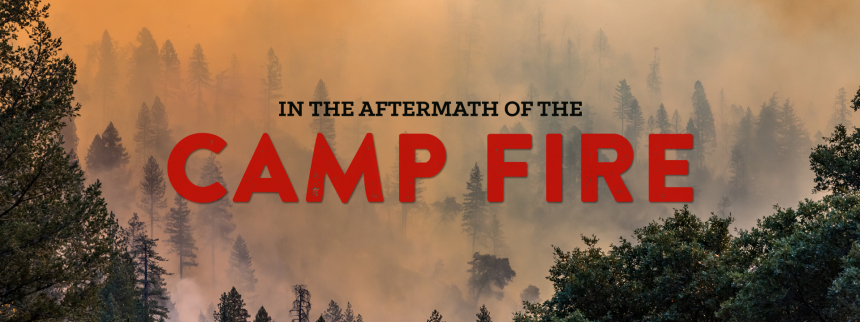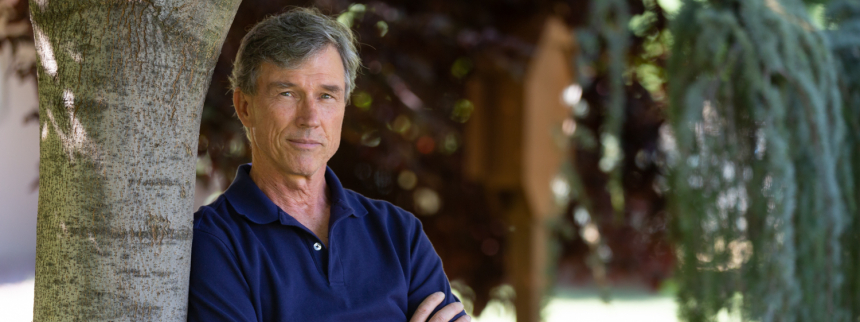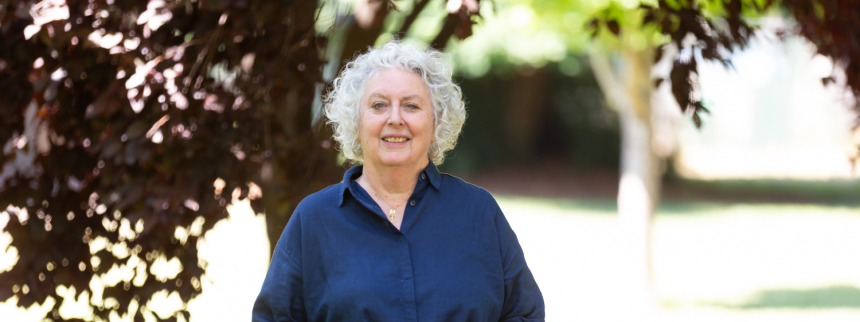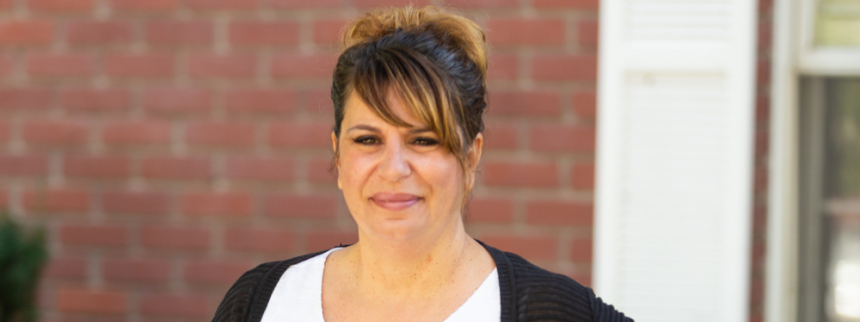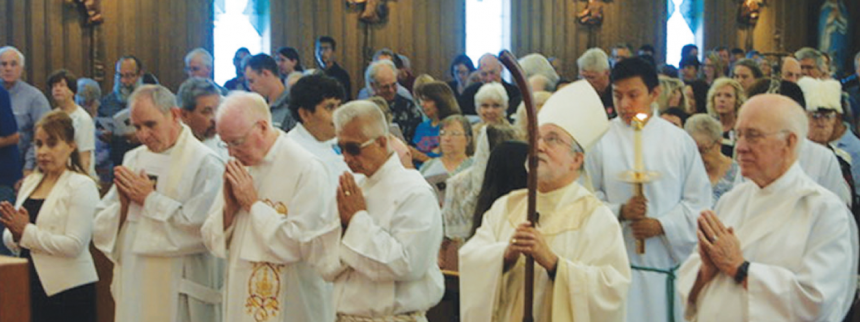
On the morning of Nov. 8, 2018, Brent Roden looked out his window into his yard. The day began, as with every other morning, with his coffee in hand and a conversation with his wife, Suzanne.
While considering the fence he was building in his yard and the art he was going to create for the day, he noticed the cloud of smoke rising east of Chico. Seeing what he described as a “beautiful, blue plume of smoke,” he knew that a late season fire had started. Brent, an artist, has an eye for beauty. "It looks like there's a fire somewhere, but isn't that a gorgeous blue,” he recalls. What had begun on this morning would change his life and the lives of thousands of others.
The devastating wildfire that roared through the towns of Paradise and Magalia in November 2018 was unexpected and life changing. The Camp Fire is the most destructive and deadly wildfire in the history of California. Fighting for containment, the coalition of firefighters and law enforcement worked tirelessly until containment was accomplished. What followed the containment of the blaze were the smoldering ashes of the fire, covering Northern California in a darkness without blue sky or sunshine.
Many of the 52,000 evacuees of the fire came down from the foothills to Chico, where the Red Cross, the Federal Emergency Management Agency (FEMA), and other recovery efforts were quickly assembled. Immediate need for relief was urgent, with a few churches and organizations opening their doors to offer immediate shelter and assistance. The scene was eerie, as it played out with low visibility and off-the-charts hazardous air quality. Constant sirens and uncertainty permeated the town of Chico.
“I was working on a couple of paintings and my fence and I remember thinking, ‘if there was just something I could do to help out, that would be great,’” says Brent, a member of Our Divine Parish in Chico and its Society of St. Vincent de Paul parish conference. "But I'm just one person. Well, the Holy Spirit heard that.”
Judy Dietlein, president of the Sacramento Council of the Society of St. Vincent de Paul (SVdP), reached out to Judith Rojas, president of the SVdP conference at Our Divine Savior Parish, in hopes of coordinating a response of immediate assistance. Out of town, Judith contacted Brent, a fellow Vincentian, for a response, only moments after he felt the call of compassion to help. Brent answered the call in an impactful way.
The establishment of the Disaster Recovery Center (DRC) was coordinated within days of the fire. In collaboration with FEMA, the center provided a central location for relief and recovery organizations to gather to begin the arduous task of picking up the pieces after such a catastrophic event. Among the many service-providing groups were the Vincentians at Our Divine Savior Parish.
“We’re neighbors helping neighbors,” describes Judith, who has been involved with the parish conference for five years. “We go to homes, we visit them. Sometimes we’re the only friendly contact (with others) that they have.'' The cases of many they have served in the past included situations such as assistance with rent payments, PG&E bills, groceries or vehicle maintenance. These are matters of relief in a time of crisis for the individual or family. The Camp Fire, however, presented a much larger need for both relief and recovery and on a massive scale.
The majority of the 12 members of the conference at Our Divine Savior are retired teachers. It is a small, fiscally self-sustaining organization of active community members with compassion towards those they encounter. However, with the Camp Fire, they were suddenly found in the midst of a crisis that played out on a national scale, resulting in an overwhelming amount of individuals needing help; an amount that was far beyond their capacity.
Within one week of the start of the fire and in coordination with the national SVdP council, an emergency response team was assembled with the help of parishioners from Our Divine Savior and St. John the Baptist Parish in Chico. These volunteers were trained in the process of intake to collect information to open cases for those affected by the fire.
Responding to the call by Father Michael Ritter, parochial administrator of St. John the Baptist Parish, 172 volunteers went through the disaster relief training for SVdP from the parishes. As Brent reflects, each of the volunteers fulfilled the Good Samaritan story from the Gospel of Luke: "Which of these three do you think was a neighbor to the man who fell..."
FEMA coordinated the DRC, where organizations such as the Red Cross, United Way and many others were present to offer relief assistance and start the road to recovery. "Relief comes before recovery,” notes Brent, in his recollection of the events after the fire. To provide something in the way of immediate assistance, gift cards to supermarkets and gas stations were given out to families and individuals at the end of the intake interview. Many of the organizations at the DRC fulfilled the need for immediate relief, while others such as SVdP prepared for the long term.
The Disasters Services Corporation, which is a non-profit arm of SVdP-USA, responds to disasters around the nation. "At the time of the Camp Fire, the SVdP Disasters Services Corporation was working on (long-term recovery from) 36 different disasters,” Brent notes.
The intake process, which occurred at the DRC, is a process for the collection of information to open cases and establish contact all who need help. The case management process is oriented towards long-term recovery, which Erna Friedeberg, regional director of program development for Northern Valley Catholic Social Service (NVCSS), says is “for this event, seven to 10 years."
NVCSS and SVdP are currently working in collaboration through the information collected from their combined intake at the DRC.
At the DRC, up to 12 volunteers conducted intake interviews at one time, with many others in queue. Most intake interviews lasted 30 to 45 minutes and they proved to be emotionally taxing for both the fire survivor and SVdP volunteer. "There was not a dry eye among our volunteers," Brent says. “The interviews offered such a tremendous complexity of a slice of humanity. Each person's story was different."
Brent and the others who responded to service bore an emotional burden through their conversations with the fire survivors.
SVdP provided 4,326 unique interviews with those affected by the disaster over the course of two months. Brent was present at the DRC every “open” day from Nov. 16 through Jan. 11.
With the closure of the DRC in January 2019, many organizations left or turned their attention towards other crises around the world. Brent and his team settled in for the long haul.
The Long Term Recovery Group was assembled to bring together government, business and non-profit leaders in Butte County to communicate on the issues brought about by long-term recovery from the fire. From this group, subcommittees formed, based on the need. Brent is an active member of the Housing Subcommittee, which seeks to coordinate the supply of housing, and sustain the feature of affordability characteristic of the Ridge.
Brent reports that of those (taken through the intake process) over 50 percent were renters. “If you take 70 percent of those, annual income was reported at $0 to $25,000, another 70 percent of those declared a disability. These are individuals who have no control over their housing,” he says. Many of these individuals will receive federal emergency assistance, though for a limited time. "These people need homes and they need essentials,” Brent says.
More than 14,000 households lost their shelter in Paradise and Magalia, with 30 percent of those people who owned properties not having insurance.
The industry standard in case management suggests that a professional case manager should handle roughly 35 cases. At this time, SVdP has two full-time case workers and NVCSS has only one. There is still a need for more case managers, in collaboration with NVCSS.
Many cases have been opened and a few have closed. NVCSS and SVdP continue in their efforts to provide assistance through case management, which could last more than a decade. Erna reminds her team "with something this big, it's easy to feel hopeless. It can be overwhelming. The little wins turn into big wins for our community. It's one day at a time.”
Some of the volunteers through NVCSS lost their own homes in the fire, yet still offer their time to serve others in the same situation. "Their giving back is helping the healing process,” Erna says.
Erna notes the objective of Camp Fire case management moving forward. "Long-term recovery is trying to pick up the pieces of the lives of the people we work with. Cement is being poured and houses are being framed. Things are happening in Paradise.”
After volunteering nearly full time for seven months, Brent's fence is finished now and he has returned to working in his art studio. He helps out a friend who is rebuilding in Paradise, while keeping an eye open for affordable and fire-resistant housing systems.
For his efforts following the Camp Fire, Brent has been named St. Vincent de Paul National Disaster Relief Volunteer of the Year. He continues on as treasurer for Our Divine Savior SVdP conference in Chico, where 30 percent of the conference’s home visits now consist of households from the Camp Fire. The conference also supports, where it can, the SVdP parish conference at St. Thomas More Parish in Paradise, reorganized now following its full flight evacuation nearly one year ago.
LEARN MORE
--About the Sacramento Council of the Society of St. Vincent de Paul at www.svdp-sacramento.org
--About Northern Valley Catholic Social Service at www.nvcss.org.
St. Thomas More Church in Paradise reopens with community celebration
After 234 days and extensive renovation following the devastating Camp Fire, St. Thomas More Church, located at 767 Elliott Road in Paradise, reopened June 30 with a bilingual Mass celebrated by Bishop Jaime Soto, with more than 500 people attending.
St. Thomas More Parish has been a fixture on the Ridge since its establishment in 1948. Before the fire, the parish had more than 1,000 families and operated the largest food bank on the Ridge, including a hot meal program and weekly food distribution.
“This has been a challenging renovation and work is still ongoing,” says Greg Kidder, parish steward. Father Martin Ramat, pastor of Our Divine Savior Parish in Chico, is priest-supervisor.
“Although the church itself was spared, we lost the pastor’s residence, offices and the family life center,” Greg says. “Smoke damage to the church was extensive, the septic system was severely compromised, and church grounds suffered so much damage that we had to remove most of the trees."
The Camp Fire scattered parish families far and wide, says Lori MacPhail, vice chair of the St. Thomas More Parish steering committee. “Since the fire, we have been deeply engaged in not only restoration and repair, but also relocation and recovery of parish families: checking on their well-being, finding housing and providing other support.”
For more information about St. Thomas More Parish, visit www.stmparadise.net or call 530-877-4501. Mass is celebrated on Sundays at 1 p.m.

